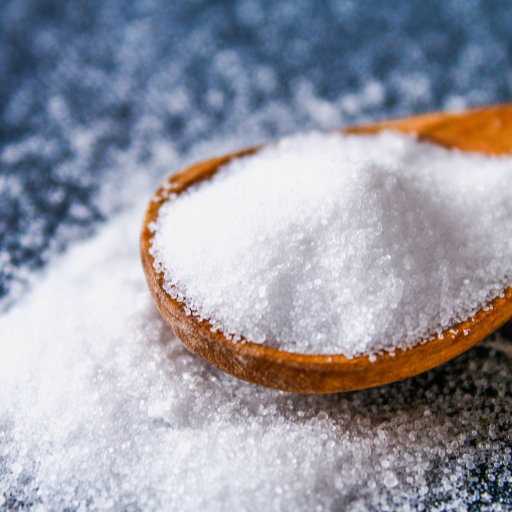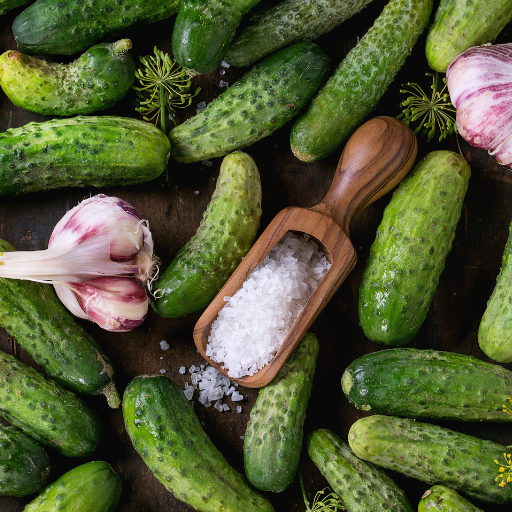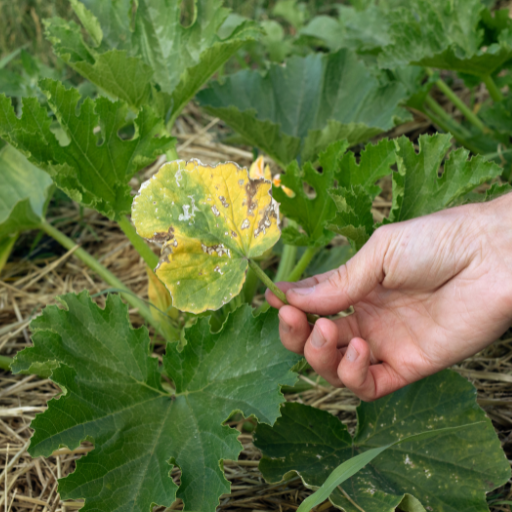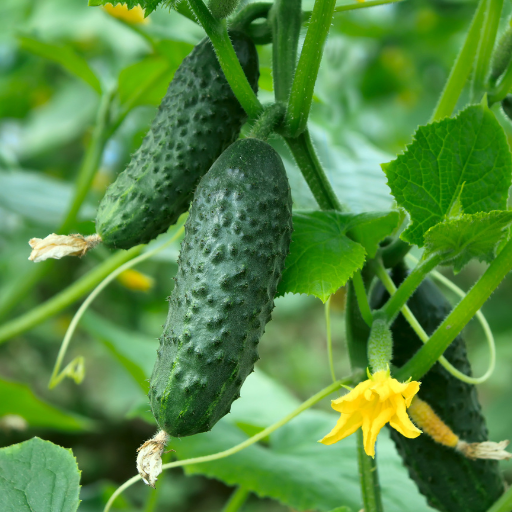In the world of farming, there is a lot of speculation and discussion regarding using various additives to promote plant growth. Epsom salt, scientifically known as magnesium sulfate, has been one such supplement that has attracted attention. This article investigates the performance of Epsom salt on cucumber plants, exploring its potential advantages and scientific bases for its application. It also offers practical guidelines regarding how Epsom salt affects nutrient absorption, plant health and ultimate yield. By being detailed and evidence-based, this blog aims to enlighten farmers about what they gain by including Epsom salts in their cucumber cultivation praxis, as well as what they stand to lose.
How Does Epsom Salt Affect Cucumber Plants?

Composed of magnesium sulfate, Epsom salts play a vital role in influencing cucumber plants by solving magnesium deficiencies in the soil. Photosynthesis could not take place without magnesium as an important part of chlorophyll. When there is enough magnesium for cucumber plants, they have more chlorophyll that comes with better photosynthetic efficiency resulting in faster growth and healthier leaves. Additionally, sulfur one of the components present in Epsom salt supports the synthesis of essential amino acids which enhances the overall health of a plant. It is worth mentioning that caution should be taken when determining the correct amounts to add, such as excess can result in nutrient imbalance and soil toxicity, thus causing damage to plants.
What Nutrients Do Cucumbers Need?
Cucumbers require certain nutrients for their proper growth and fruit formation. Nitrogen (N), phosphorous (P) and potassium (K), often called macronutrients or major elements are among them. Nitrogen is required for vegetative growth aiding robust stems and lush foliage formation. Phosphorus aids in root development and energy transfer within the plant while potassium boosts disease resistance and improves fruit quality as well as other characters associated with plant vigor.
Cucumbers also need secondary nutrients including some trace elements besides these macronutrients.Magnesium (Mg) is obtained from Epsom salt necessary for chlorophyll synthesis and photosynthesis.Calcium (Ca) stabilizes cell walls allowing for root development while sulfur(S)fosters amino acid synthesis.Similarly, small amounts of iron(Fe), manganese(Mn), zinc(Zn)and boron(B) are all essential trace elements needed for enzymatic functions as well as general plant metabolism.
The following are recommended parameter ranges in soil for precise nutrient management:
- Nitrogen—50-70 ppm
- Phosphorus—20-30 ppm
- Potassium—150-200 ppm
- Magnesium—25-50 ppm
- Calcium—1500-2000 ppm
- Sulfur—20-30 ppm
Soil tests should be conducted to ensure that nutrient levels fall within these optimal ranges. This will enable targeted fertilizer application and minimize the risk of imbalance or nutritional deficiency, which may impair cucumber growth and yield.
What is the Role of Magnesium in Plant Growth?
Magnesium (Mg) has an important role to play in plant development due to its central position in chlorophyll which is vital for photosynthesis. Chlorophyll enables plants to convert light energy into chemical energy, thus providing carbohydrates for growing. Apart from its role in chlorophyll, magnesium acts as a cofactor in several enzymatic reactions including those of carbon fixation, protein formation and nucleic acid metabolism.
Magnesium assists in the uptake and movement of other necessary nutrients inside a plant making sure that it takes them with it as it grows well-balanced nutrition and optimum body function. It supports protein synthesis by stabilizing ribosomal structure enhancing overall plant vigor. The mobility of magnesium within a plant leads to interveinal chlorosis beginning with older leaves which reallocates the finite resources of magnesium to younger tissues.
Technical parameters for magnesium in soil typically recommend a concentration range of 25–50 ppm.These values support sufficient chlorophyll production and enzymatic activity while avoiding toxicity or competitive inhibition among essential elements.As such, regular checks on soil chemistry and specific application of magnesium sources like Epsom salts (magnesium sulfate) will help retain these levels, promoting better healthiness and crop returns.
Epsom Salt: Can it Serve as a Fertilizer for Cucumbers?
Yes, it can be used as a fertilizer in cucumbers. Epsom salt is the same as magnesium sulfate which is an available source of both magnesium and sulfur, essential nutrients for cucumber growth. Magnesium is crucial for chlorophyll production and photosynthesis, while sulfur is important for protein synthesis. Since magnesium deficiency may lead to poor plant health and yield reduction, applying Epsom salts could help alleviate such deficiencies thus improving overall crop productivity. However, soil tests must be done first to inform on the levels of the existing nutrients before applying Epsom salt as part of a well-rounded fertilization program to avoid nutrient imbalances.
How to Use Epsom Salt on Cucumber Plants?
In order to efficiently use Epsom salt on cucumber plants, start by dissolving 1 tablespoon of Epsom salt in a gallon of water. To do this, pour the solution as a foliar spray or soil drench. For application through the leaves, spray it directly onto them making sure every leaf is covered. This method makes magnesium enter inside quickly via leaf surface. For applying it in the soil put the Epsom salt solution around the base of cucumber plants for gradual nutrient uptake from root systems. The amount recommended is after every two to four weeks depending on plant needs and magnesium levels present in soil during growing period of these crops. Regular monitoring and soil testing can help optimize frequency and strength of Epsom salt applications.
Mixing Epsom Salt Solution for Cucumbers
- Epsom Salt Amount: You need 1 tablespoon Epsom salts measured out with tablespoons (about 15 grams). Such an amount is enough for one gallon (3.8 liters) of water to make an effective magnesium solution.
- Dissolve in Water: Take one gallon of water into a container; you may want to heat it slightly for better dissolution. Keep stirring whilst adding slowly more crystals until they completely dissolve in water. Make sure that your mixture has combined well so as not to leave any lumps behind.
- Application Methods:
- Foliar Spray: Pour this mixture into a spray bottle or garden sprayer. Apply the above-mentioned solution directly onto your cucumber’s leaves, focusing on the underside parts where magnesium absorption occurs at its best rate. This technique allows these crops to absorb magnesium faster.
- Soil Drench: Then, pour this evenly around each plant’s base, allowing its roots to gradually take up all supplied substances.
- Frequency of Application: According to some sources, apply the Epsom salt solution every two to four weeks throughout the growing season, thus ensuring a steady nutrient supply and preventing low magnesium levels. Adjust the frequency depending on the results of a soil test and observations of plant health.
- Monitoring and Adjustment: Regularly check your cucumber plants’ conditions and conduct soil tests to assess magnesium levels in it. Adjustments can be made depending on cucumber needs so that there are no imbalances associated with nutrient availability from Epsom salt application.
Epsom Salt Dosage Recommended
General Garden Dosage:
Most gardening experts, like the Royal Horticultural Society, advise using 1 tablespoon (14.8 grams) of Epsom salt per gallon of water. This dose supplies an adequate amount of magnesium for plant growth without excess salts in soils.
Preventive and Maintenance Dosage:
To maintain healthy plants, Gardening Know How proposes a preventive dosage of around 2 tablespoons (29.6 grams) per gallon of water, ensuring an all-year supply of magnesium for crops.
Correction of Deficiency:
However, when correcting such deficiencies in plants, Michigan State University Extension suggests utilizing up to three tablespoons (44.4 grams) per gallon of water. For example, higher concentration should be used only if this has been confirmed via soil test results that farmer was suffering from deficiency problems existence at the time when he was applying this substance leading need continuous supply through leaves.
When Should You Use Epsom Salt on Cucumber Plants?

Having noted the above, remember that for cucumber plants, Epsom salts are most beneficial when used at certain stages of growth and under specific conditions. Firstly, in order to reduce transplant shock and root establishment during the initial stage of cucumber seedlings transplantation, one should use Epsom salt. Secondly, applying Epsom salt at flowering and fruiting times ensures that there is sufficient supply of magnesium that will facilitate proper blooming as well as subsequent fruit growth. It would also be helpful to introduce some Epsom salt when you see signs of magnesium deficiency such as yellow leaves with green veins. Always conduct soil tests in conjunction with Epsom salts application for aeration to analyze nutrient availability through an intensive monitoring on plant condition to allow adjustment of both frequency and amount applied corresponding to cucumber requirements.
Best Time To Apply During The Stages Of Growth
- Transplanting Seedlings: When transplanting cucumber seedlings, 1 tablespoon (14.8g) of Epsom salt per gallon can help reduce transplant shock while promoting good root development. This dosage provides enough magnesium required for healthy young plants.
- Flowering Stage: For every one or two tablespoons (14.8-29.6g) of Epsom salt per gallon water used during the blossoming period is beneficial to the well-being of blossoms as it decreases blossom-end rot risk. With this application, sufficient magnesium will always be maintained while ensuring strong flower formation needed for successful fruit set.
- Fruit Development: From here until the maturation stage, maintain consistent levels by adding another 1-2 tablespoons (14.8-29.6g) per gallon of water supplied to cucumbers grown using Epsonsalt. In this case, the minutes after fall back off until fruits develop fully without yellowing leaves, which may occur due to a lack of Magnesium and result in inferior-quality fruits.
Seasonal Considerations for Epsom Salt Application
Spring is a critical period for the use of Epsom salt in cucumbers, particularly due to increased growth rates and nutrient demands. It is advisable for one to carry out soil tests prior to the commencement of the growing season to measure existing magnesium levels. In case there are deficiencies, then you can begin applications earlier so that the soil is well prepared. During this time, a baseline application of 1 tablespoon (14.8 grams) of Epsom salt per gallon of water every two weeks will help stabilize magnesium levels in your system.
In summer, the focus should be on maintaining magnesium levels during high fruit productivity and heat stress conditions. This process can lead to rapid depletion of nutrient due to an increase in transpiration rates. Thus biweekly or even weekly applied might become necessary. The dose recommendation remains 1-2 tablespoons (14.8-29.6g) per gallon of water from leaf analysis results, plus regular monitoring will allow making adjustments at the right time.
Fall applications should be more conservative as plant growth slows down. For instance, it’s recommended applying 1 tablespoon (14.8 g) of Epsom salt per gallon on a monthly basis without oversaturating soils with magnesia content. Also, as the season approaches frost, applications should be minimized since plants are less active, thereby reducing uptake quantities towards close-down time while awaiting a quality report after harvest before the next planting.
Lastly, during winter months or the off-season, leveraging Epsom salt as a soil conditioner can offer benefits. Add this to your soil at a rate of 1 cup (240g) per 100 sq ft during the pre-planting soil preparation exercise for a favorable Mg content throughout the next farming year.
What Are the Benefits of Using Epsom Salt for Cucumbers?

Magnesium is essential to the chlorophyll molecule and is therefore vital in photosynthesis leading to vigorous plant growth and increased productivity. Additionally, Epsom salt makes it easier for plants to absorb vital nutrients such as nitrogen and phosphorus hence aiding in more efficient nutrient utilization.
Moreover, it even helps prevent some of the most common deficiencies causing problems like yellow leaves or poor fruit productivity when used on a regular basis. Sulfur contained in it ensures enzyme function and protein synthesis that contributes to general plant well-being. As cucumbers are highly sensitive to magnesium shortages, these interventions can lead to healthier vines, improved flowering, and ultimately, higher yields and better fruit quality.
Does Epsom Salt Improve Fruit Production?
Yes, using Epsom salt mainly because of its magnesium content can help improve fruit production in cucumbers. The element plays a central role in photosynthesis since its nucleus forms part of the chlorophyll molecule. Improved photosynthesis leads to stronger plants that bear more fruits. The best source points out that approximately one tablespoon per gallon of water will be the right amount of Epsom salt applied as foliar spray or soil drench every two weeks. Technical parameters from these sources recommend:
- Dosage: 1 tablespoon (approximately 14.3 grams) of Epsom salt per gallon of water.
- Frequency: Every two weeks during the growing season.
- Method: Foliar spray or soil drench.
Being comprised with magnesium component; also promoting nutrient absorption especially nitrogen and phosphorus which are vital for fruit development, this compound helps cucumbers take up minerals effectively thus improving their health during fruit set resulting into boosted yields. This implies that there is an increase in the activity level of enzymes plus the synthesis of proteins by sulfur contained within Epsom salts, thereby increasing crop growth as well as yield.
Can Epsom Salt Prevent Plant Diseases?
Although Epsom salt may not directly prevent plant diseases, it could enhance plant health and lessen their susceptibility to various disorders. Epsom salt’s magnesium and sulfur content improves plant vigor by improving photosynthesis and cellular processes. The best source explains that when plants are in a healthy state, they are more resistant to diseases.
Technical Parameters:
- Magnesium Content: Approximately 10% of Epsom salt’s weight is magnesium, which is required for chlorophyll production and leads to disease resistance through vigorous growth.
- Sulfur Content: It contains about 13% sulfur. Sulfur aids enzyme activities needed to synthesize proteins that help plant cells develop defense mechanisms against pathogens.
- Application Method: Foliar sprays have quick uptake with immediate effect while soil drenches provide steady supply of magnesium to the roots.
- Usage Rate: Weekly application with 1 tablespoon (approximately 14.3 grams) per gallon of water has been recommended as an effective way to get optimum benefits from plant health improvements.
By enhancing nutrient uptake and encouraging strong growth in the cucumber plant, Epsom salt indirectly supports disease prevention. Yet, it should be part of an all-inclusive program for crop care rather than being used solely as a medicinal agent against diseases.
How to Identify Magnesium Deficiency in Cucumber Plants?

There are many identifiable symptoms of magnesium deficiency in cucumber plants. Its onset is marked by interveinal chlorosis, where the veins on the leaves remain green and the areas between them turn yellow. This yellowing starts with older leaves since magnesium, being a mobile plant nutrient, will be transported to newer growth if it is lacking. Also affected could be leaf fragility and marginal necrosis as the disease progresses. In severe cases, this can lead to overall growth retardation of the crop thus poor fruit yield. Monitoring these signs regularly while carrying out soil tests can help confirm magnesium deficiency hence enable timely correction via appropriate fertilization practice.
Typical Symptoms
- Interveinal Chlorosis: This term refers to a distinct yellowing of leave tissues while veins remain green mostly observed on older ones. It results from inadequate supply of magnesium which disrupts key biochemical processes connected with chlorophyll.
- Marginal Necrosis: Marginal necrosis is also known as brown edges occurring when magnesium shortage advances and cells start dying at their ends turning them brown. Death occurs due to lack of life support functions in plants.
- Stunted Growth: Magnesium is essential for energy production and enzyme activation in plants; its deficiency leads to stunting, which limits both plant size and fruit yield. This is especially true in commercial farming, where productivity matters most.
Soil testing should confirm that levels fall below an optimum range of 20-50 ppm (parts per million). A soil test that takes into account any potential toxicity should guide the application rates for Epsom salt or other magnesium-containing fertilizer.
Testing Soil Magnesium Levels
Different standardized methods exist that can accurately test for soil Mg levels. Commonly used method includes extraction of Mg from soils using a chemical extractant such as Ammonium acetate or Mehlich-3 followed by analysis using Atomic Absorption Spectroscopy (AAS) or Inductive Coupled Plasma Optical Emission Spectrometry (ICP-OES). Such methods involve this type of sample quantification which is often necessary in agricultural diagnostics.
- Soil Sampling and Preparation:
- Soil samples should be taken from several locations within the area of interest to obtain a representative result.
- Soil needs to be thoroughly mixed and air dried.
- The soil should then be sieved using a 2 mm sieve to eliminate any debris or large particles.
- Chemical Extraction Methods:
- Ammonium Acetate Extraction: Mix one part of soil with ten parts of ammonium acetate solution and shake for 30 minutes in order to extract exchangeable magnesium. Usually, another time span of 30 minutes would do the job properly.
- Mehlich-3 Extraction: Mehlich-3 solution can be mixed with soil at a ratio of 1:10. It suits many types of soils.
- Analytical Techniques:
- Atomic Absorption Spectroscopy (AAS): This method involves subjecting the soil extract to heat so as to atomize the magnesium which will absorb light at a specific wavelength measurable to determine concentration of Mg in it.
- Inductively Coupled Plasma Optical Emission Spectrometry (ICP-OES): This method involves ionizing the components of the soil extract by high temperature plasma with emitted lights measured at specific wavelengths that indicate amounts of Mg present in it.
Technical Parameters
- Optimal Soil Preparation: Soil should be sieved to 2 mm and allowed drying in open air.
- Extraction Time: Generally, either ammonium acetate or Mehlich-3 methods take about thirty minutes.
- Soil-to-Solution Ratio: Both extractants have an equal concentration ratio relative to their volume i.e. one part soil mixed with ten parts solution.
- Detection Limits: The detection limits are usually low; both AAS and ICP-OES have limits ranging from .01-.1 ppm for Mg.
When undertaking these particular methods and using the right analytical procedures to determine soil magnesium levels, informed agricultural decisions can be made.
Comparison with tomato plant nutrient deficiency challenges
Mostly, it is interveinal chlorosis that indicates a tomato plant has magnesium deficiency where the areas between leaf veins get yellow while leaves remain green. The problem usually begins in the old leaves and then extends to new shoots when not corrected. Besides, the meticulous modes of chemical extraction and accurate methods of analysis, such as AAS and ICP-OES, facilitate proper quantification of soil’s magnesium levels. Soil health is directly affected when magnesium content falls below optimum levels, thus justifying the significance of these techniques for early detection and control of nutrient shortfalls. Precise soil testing allows targeted application of fertilizers hence mitigating magnesium deficiencies in tomatoes resulting to healthy crops.
Can Epsom Salt Harm Cucumber Plants?

Magnesium sulfate popular among gardeners as Epsom salt when applied could either be good or harmful to the cucumber plants. Some of the benefits include correcting magnesium deficiency that enhances photosynthesis and promotes healthier plant growth. But, excessive use can disrupt the nutrient balance of the soil leading to calcium and potassium uptake inhibition which in turn harms cucumbers. Proper dosage is important; normally, one tablespoon dissolved in a gallon of water is recommended for periodical application thus avoiding negative effects. Soil tests should be conducted before applying Epsom salts because too much magnesium may not be required.
What signs show if Epsom Salt has been overused?
- Leaf burn and yellowing: Excessive magnesium sulfate will result in leaf burns, where leaves turn brown along the edges and become crispier due to inadequate absorption of other essential nutrients, thereby creating an imbalance in nutrient content. Yellowing of leaves is also common, especially on older ones.
- Stunted Growth: Overdosing on Epsom salt may cause stunted growth since it contains a high amount of magnesium, which hinders other essential elements like calcium and potassium from being taken up by plants, thus slowing down or even stopping their development.
- Flower and fruit drop off: Consequently, flowers and fruits are seen falling off as a sign of excess fertilizer. This disrupts the physiological functions such as retention of reproductive parts by upsetting nutrient balances within plants brought about by nutrient imbalances in soil.
- Salt Build-up in Soils: Salt accumulation may result from prolonged use of this product in more than required quantities. Salinity negatively affects soil structure, leading to poor drainage capacity and, thereby, more nutritional deficiencies. To know if there are accumulations, one can do a salinity test with parameters such as EC (Electrical Conductivity) exceeding optimal levels (above 4 dS/m is normally considered saline soils).
Precautionary Measures While Using Epsom Salt
- The Correct Dosage: It’s necessary to depend on the recommended levels of Epsom salts. Generally, one or two tablespoons per a gallon of water for crops are enough. Anything above this would bring nutrients imbalances and cause soil salinity.
- Application rate: If used in most plants, the mixture should be applied at least once a month, especially during the growing season. Overapplication will lead to an accumulation of nutrients and other related difficulties.
- Soil Testing: A soil test is important before applying any Epsom salt because it reveals magnesium deficiency. Readings less than 50 ppm (parts per million) usually mean magnesium addition is required.
- Monitoring pH Levels: As little as it may be, Epsom salt application can increase the acidity of soils under consideration hence need for monitoring pH levels within 6.0 – 7.0 range to maximize nutrient availability to the majority of garden plants.
- Avoiding Contact with Leaves on Hot Days: Do not apply foliar feedings during high sunlight time or very hot days when temperatures are extreme otherwise you will burn your leaves. Morning or late evening hours are best suited for applying Epsom salt solutions.
- Balanced Nutrient Use: Use other fertilizers properly so that they don’t compete with each other. Epsom salt is one balanced fertilizer that contains nitrogen, phosphorus, and potassium. It helps maintain overall nutrition balance and prevent calcium and potassium deficiency situations.
- Watering Techniques: Adequate watering practices are necessary. In poorly drained areas, excess magnesium is more rapidly built up, causing toxicity. Always ensure that the soil is well-drained and water moderately to prevent waterlogging.
Frequently Asked Questions (FAQs)
Q: What is Epsom Salt?
A: Epsom salt, chemically known as magnesium sulfate, is a mineral compound often used in gardening to enhance plant growth and health.
Q: Is Epsom Salt beneficial for cucumber plants?
A: Yes, Epsom salt is beneficial for cucumber plants as it provides magnesium, a critical nutrient that plants need for photosynthesis and overall health.
Q: How do I apply Epsom Salt to my cucumber plants?
A: You can mix Epsom salt with water to create a spray solution. Apply it to the soil or directly onto the leaves of your cucumber plants for best results.
Q: How much Epsom Salt should I use per plant?
A: A general guideline is to mix one tablespoon of Epsom salt with a gallon of water. Each cucumber plant can be sprayed or watered with this solution about once a month.
Q: Can Epsom Salt help with seed starting for cucumbers?
A: Yes, Epsom salt can help it along by providing essential nutrients during the seed starting phase, ensuring your seedlings grow strong and healthy.
Q: Are there any risks associated with using Epsom Salt on cucumber plants?
A: While Epsom salt is generally safe, overuse can lead to an excess of magnesium in the soil, which may negatively affect plant health. Moderation is key.
Q: How does Epsom Salt help in the growth of cucumber plants?
A: Epsom salt provides magnesium, which helps in chlorophyll production and nutrient absorption, vital processes for healthy cucumber growth.
Q: Can I use Epsom Salt along with other gardening solutions like neem oil or peppermint oil?
A: Yes, Epsom salt can be used alongside other gardening treatments like neem oil and peppermint oil. However, ensure you follow recommended dosages to avoid plant stress.






